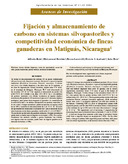| dc.description.abstract | Se evaluó el almacenamiento de carbono (C) en pastos tradicionales (Hyparrhenia rufa, Paspalum notatum, Paspalum virgatum) y pastos mejorados (Brachiaria brizantha, Panicum maximun, Cynodon dactylon), con árboles dispersos y sin ellos (más de 15 especies), y en áreas de regeneración natural (tacotales edades entre 5-20 años), en el municipio de Matiguás, Nicaragua. El C total almacenado en los tacotales (201 tC ha exponente -1) fue superior al almacenado en pastos con (164-170 tC ha exponente -1) árboles y sin ellos (151-159 tC ha exponente -1). Los sistemas de pasturas mejoradas con árboles maximizan el ingreso (óptimo económico) del productor. El tacotal es el que más C almacena (óptimo ecológico), pero genera bajos ingresos al agricultor. La conversión de la mitad de la finca a un sistema silvopastoril con pasturas mejoradas, y la otra mitad a bosque secundario, puede incrementar el ingreso actual en un 43 por ciento y aumentar el almacenamiento de C en 15 tC ha exponente -1. El costo de oportunidad de incrementar el secuestro de C por el desarrollo de las áreas boscosas en las fincas ganaderas osciló entre 3,2 y 26,4 dolares tC exponente -1. Un cambio de uso del suelo de ganadería extensiva a bosques secundarios puede tener un fuerte impacto negativo en el empleo (-47 por ciento). En cambio, transformar los sistemas actuales a pastos mejorados con árboles, con algunas áreas en tacotales, puede tener un impacto positivo en la demanda de trabajo (+74 por ciento). Carbon (C) storage was evaluated in tradicional pastures (Hyparrhenia rufa, Paspalum notatum, paspalum virgatum) and improved pastures (Brachiaria brizantha, Panicum maximun, Cynodon dactylon), with and without dispersed trees (over 15 species), and in natural regeneration (secondary forest 5-20 of age) in the district of Matiguas, Nicaragua. Carbon storage in the secondary forest (201 tC ha exponent -1) was greater than in pasture systems with (164-170 tC ha exponent -1) or without trees (151-159 tC ha exponent -1). The improved pasture systems with trees maximizes farmers' revenues (economic optimum), while secondary forests store more C (ecological optimum) but with less revenue to the farmers. Converting 50 per cent of a farm to silvopastoral systems with improved grasses, and the other 50 per cent to secundary forest, could increase actual revenues by up to 43 per cent and at the same time increase C storage by 15 tC ha exponent -1. The opportunity cost of increasing C sequestration by increasing forest areas in livestock farms is between 3.2 and 26.4 dollars tC exponent -1. A land use change from extensive cattle rising to secondary forests could have a negative impact on employment (-4 per cent). On the other hand, a change to systems with improved grasses and trees, with some areas in natural regeneration, could increase labour demand (+74 per cent). | es_ES |



